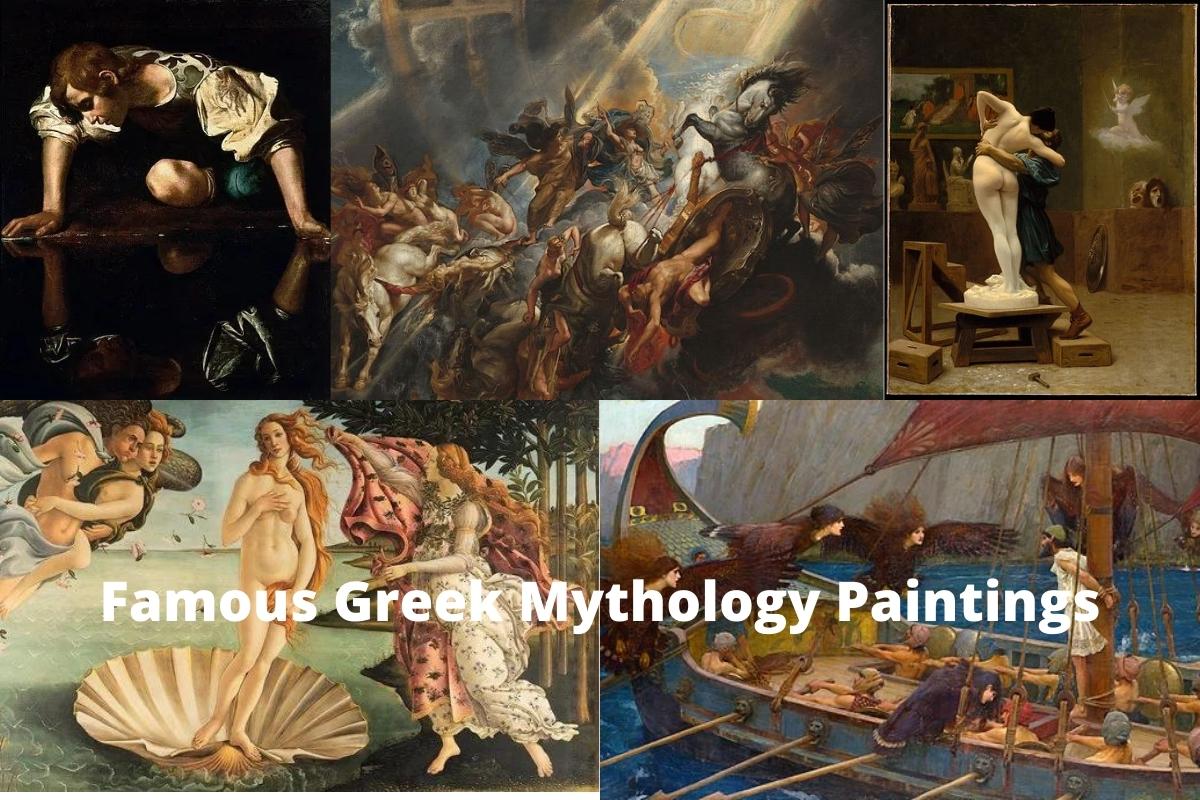Greek mythology has been the focus of artists from multiple art movements that stretch across many centuries going back before the Italian Renaissance.
The gods and goddesses that people in ancient Greece worshiped and adored are known for having intriguing personalities and characteristics that make them completely unique from one another.
Many artists throughout history have centered their paintings around the stories and legends associated with Greek mythological figures. The topic of Greek gods and goddesses had been especially popular during the Renaissance and once again emerged during the Classical styles that took place during the 18th and 19th centuries.
In this article, we will outline 10 of the most famous Greek Mythology paintings from history and include details related to the artists that created them.
Famous Greek Mythology Paintings
1. The Birth of Venus – Sandro Botticelli
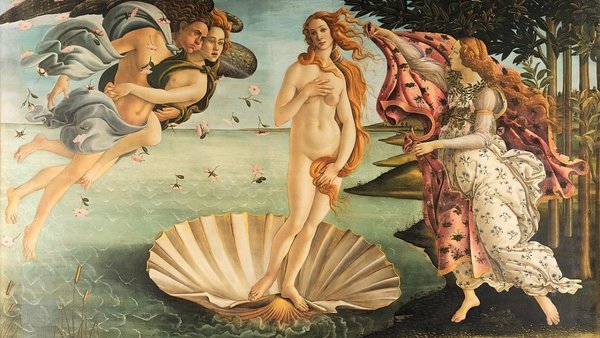
Sandro Botticelli was one of the more prominent figures from the early Italian Renaissance era. His works focused heavily on figures from the Christian religion, as well as highly-esteemed individuals from Italy’s different city-states.
However, much of Botticelli’s paintings revolves around Greek mythology in a way that celebrates the attributes and qualities that mythological figures had while also highlighting the many stories associated with them.
One of the works that historians and critics consider to be Botticelli’s most well-known paintings is titled The Birth of Venus. This 1486 work features a scene that has become iconic in the centuries that have passed since it was painted. It prominently presents the goddess Venus, who is known as Aphrodite in Greek mythology, in the middle of the canvas.
Aphrodite was the main goddess associated with beauty, love and reproduction. Other Greek or Roman gods or goddesses can be seen on either side of Aphrodite. These include the wind god, Zephyr, as well as others, yet the specific identity of these gods and goddesses are disputed among historians and critics.
The work includes various themes related to ancient painters and is believed to have been commissioned by the powerful Medici family that ruled over Florence at this time.
2. Pallas and the Centaur – Sandro Botticelli
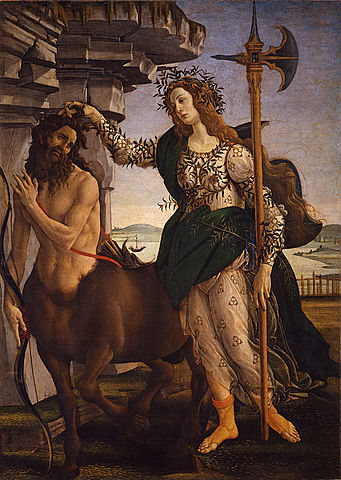
Another one of Botticelli’s most famous paintings is one that also focuses on Greek mythology. Many artists from the early Italian Renaissance painted scenes from various Greek legends and included veiled references to the Christian religion that had become the dominant faith in the region over the centuries before the movement.
The painting is titled Pallas and the Centaur and is believed to have been completed sometime around 1482 when Botticelli was working mostly in Rome on some of his other paintings that are also considered to be masterpieces.
The figure of the Pallas is associated with that of Athena, which is known as the goddess of wisdom and ingenuity while the figure of the centaur is one that’s often associated with uncontrolled passion in Greek mythology.
The pairing of these two figures has multiple possible connotations and critics and historians argue over the exact reasons why Botticelli created the painting. The centaur appears to be submissive to Athena, but some posit that the half-man/half-beast figure is being tamed by Athena in this scene.
3. Pygmalion and Galatea – Jean-Léon Gérôme
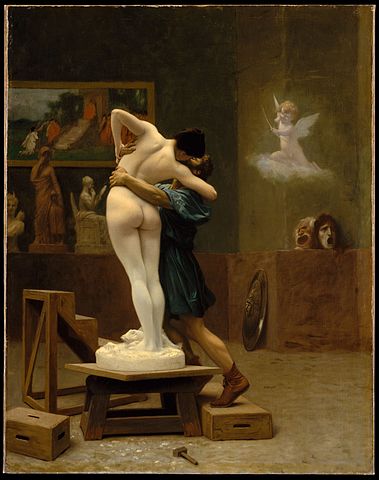
Jean-Léon Gérôme was a famous French painter and sculptor who produced works that often contained Classical themes related to Greek mythology. He lived in the 19th century, but was not closely associated with popular movements like Impressionism as many of his contemporaries were.
Gérôme produced many paintings that are among the more famous Greek mythology works in existence today, but one of his greatest masterpieces is considered to be preeminent among those works.
The painting is titled Pygmalion and Galatea and was completed in 1890. It depicts a scene from a famous poem written by a Roman poet named Ovid.
The painting depicts the exact moment in the poem in which Pygmalion, the sculptor, kisses the goddess Aphrodite after she comes to life.
The work is highly-detailed, which is similar to many of Gérôme’s other paintings and many critics believe it closely resembles the artist’s actual studio, which held many sculptures created by the artists.
4. The Lament for Icarus – Herbert James Draper
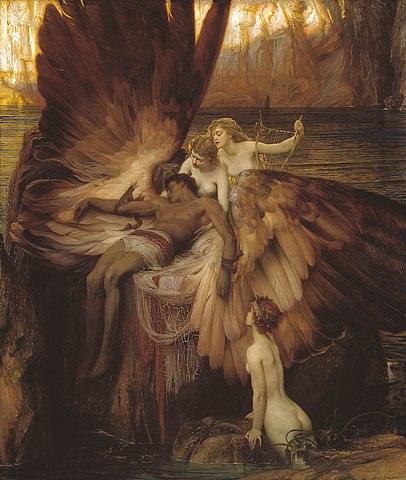
Herbert James Draper is another artist who is known for his work in Classical themes that often revolved around Greek mythology.
Born in England in 1863, Draper was one of the more distinguished artists that focused his efforts on painting figures and themes related to Greek and Roman mythology.
Many of these works from Draper are among the more well-known paintings done by Classical artists in the 19th century.
One of Draper’s most famous masterpieces is titled The Lament for Icarus. The work is believed to have been completed 1898 at the end of a decade in which the artist focused the majority of his efforts on painting Greek mythology scenes.
While many of the more well-known works that depict the story of Icarus typically focus on the moment of his downfall, Draper centers this painting around the time after Icarus had died.
Icarus is surrounded by nymphs and this particular painting is considered to be one of Draper’s greatest works by some of the most notable critics of late 19th century art.
5. Prometheus Bound – Frans Snyders and Peter Paul Rubens
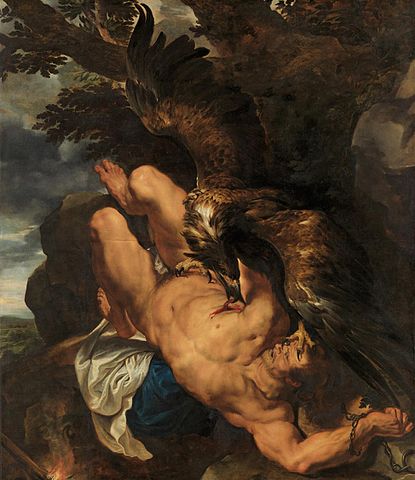
Peter Paul Rubens is one of the more notable artists from the 17th century and had a reputation for painting scenes that depicted mythological figures from both Greek and Roman legend.
He is considered to be one of the most prominent Baroque artists and was friends and associates with some of the other masters of this movement such as Diego Velázquez and others.
One of Rubens’ most popular paintings during his lifetime is titled Prometheus Bound. The work was painted in 1612 and is one of the artist’s first paintings that drew widespread acclaim as it was a collaborative effort with another famous artist, Frans Snyders. The figure of Prometheus was painted by Rubens while the giant eagle was done by Snyders.
The painting has been praised throughout the centuries since it was created for its originality and for its incredible realism in its depiction of the legendary story of Prometheus that tells of his liver being devoured by eagles every day.
6. The Fall of Phaeton – Peter Paul Rubens
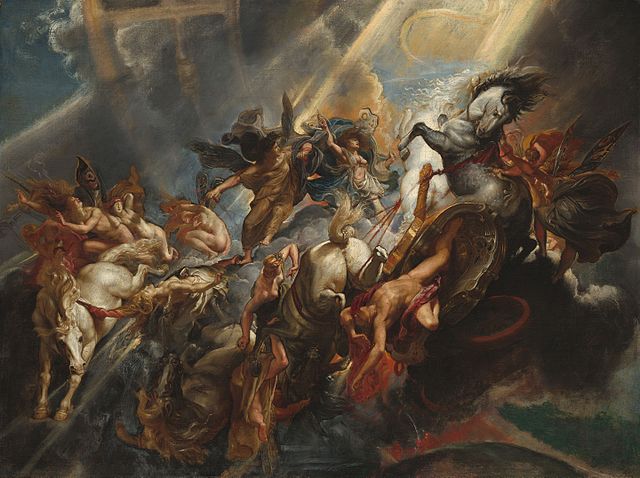
Another painting that was done by Rubens is also a worthy addition to our list of famous Greek mythology paintings. Rubens created a number of famous depictions of mythological figures and stories, but few drew as much praise as his portrayal of the legend involving Phaeton.
This painting is titled The Fall of Phaeton and was said to have been completed around 1604 or 1605, but many historians and critics believe more work was done to the canvas at a later date, possibly around 1610.
The painting is famous for its depictions of the Greek god Zeus, as well as others. Rubens is known for being especially talented in creating scenes at the height of dramatic action and intensity, which was unlike any other artist from this period of the Baroque movement, or afterward.
7. Oedipus and the Sphinx – Gustave Moreau
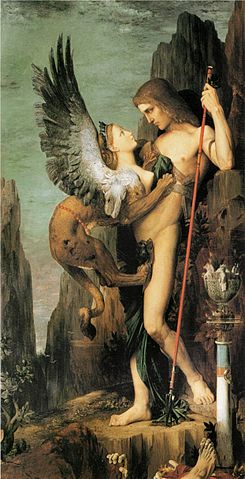
Gustave Moreau is a prominent French painter who created a number of dramatic works that contained scenes and images from Greek or Roman mythology.
Born in Paris in 1826, Moreau worked in a time when the Impressionist movement was in full swing, but his works are very much unique and were done according to a style that is typically compared to a movement known as Symbolism.
One of Moreau’s most famous paintings is a work titled Oedipus and the Sphinx, which was completed in 1864. This painting was one of the artist’s more successful works and received high praise from the first time it was exhibited in the Paris Salon in 1864.
Moreau portrays Oedipus, according to legend, at the moment he meets the Sphinx and has to answer a famous riddle in order to gain passage onward.
8. Perseus and Andromeda – Frederic Leighton
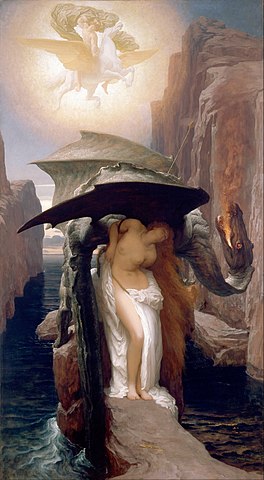
Frederic Leighton was another artist who was part of the collective of English painters that focused heavily on Greek mythology and other legendary stories and myths during the 19th century. He created works in a way that included high amounts of intricate detail, as well as dramatic movement that many critics compare to the Romantic movement.
One of his more famous works is titled Perseus and Andromeda and depicts a scene from the well-known Greek myth that has been portrayed in film and art for centuries.
The painting features the figure of Andromeda at the moment she is set upon by the sea monster. She is painted in a way that highlights her innocence and purity as the artist uses bright colors and white tones to depict her and Perseus.
9. Ulysses and the Sirens – John William Waterhouse
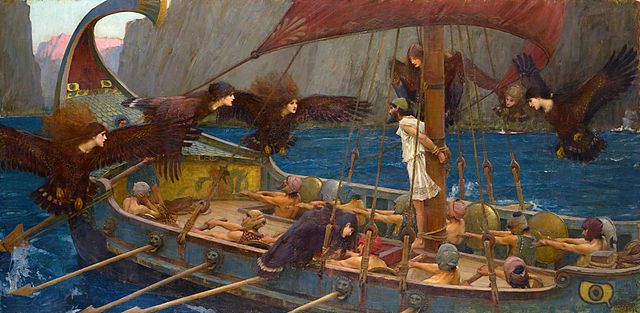
John William Waterhouse is another English painter who embraced the same style as others from the Academic movement, but was known for creating many works depicting mythological figures that were adorned in dresses and other attire that were common among people of England at the time.
One of Waterhouse’s more famous paintings is titled Ulysses and the Sirens. This 1891 painting depicts the well-known story of Ulysses(Odysseus) and features the Greek figure while he is tied to the mast of the ship in an effort to prevent him from succumbing to the lure of the Sirens.
Waterhouse portrayed the evil songstresses as flying bird-like figures that had heads like women.
10. Narcissus – Caravaggio

Caravaggio is arguably the most famous figure from the Baroque movement and he is known for creating many works that include figures from Greek mythology. Like other artists from the same time period, Caravaggio painted figures in ways that used heavy amounts of light and dark contrasts to depict good and evil.
One of his most famous paintings is titled Narcissus and is believed to have been completed in 1599 at a time when the artist was at odds with numerous factions from Italy’s city-states.
The work is a masterpiece among those featuring Greek and Roman mythological figures and his depiction of Narcissus shows the figure gazing into a pool of water while dressed in clothing that was common for people in Italy at the time.
11. The Triumph of Galatea – Raphael
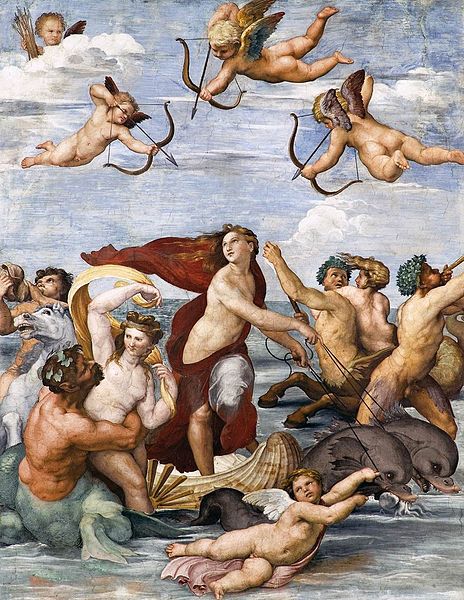
Raphael is known as one of the most prominent artists from the Italian Renaissance movement. He famously depicted figures from both Greek and Roman mythology, as well as the Christian religion in his works.
One of Raphael’s most well-known works of art that features a mythological scene is titled The Triumph of Galatea, or is simply referred to as Galatea.
This painting is believed to have been completed around 1512 and was a fresco work that was done on the wall of the Villa Farnesina in Rome.

